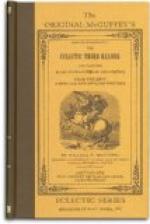3. There are several species of the eagle. The golden eagle, which is one of the largest, is nearly four feet from the point of the beak to the end of the tail. He is found in most parts of Europe, and is also met with in America. High rocks and ruined and lonely towers are the places which he chooses for his abode. His nest is composed of sticks and rushes. The tail feathers are highly valued as ornaments by the American Indians.
4. The most interesting species is the bald eagle, as this is an American bird, and the adopted emblem of our country. He lives chiefly upon fish, and is found in the neighborhood of the sea, and along the shores and cliffs of our large lakes and rivers.
5. According to the description given by Wilson, he depends, in procuring his food, chiefly upon the labors of others. He watches the fish hawk as he dives into the sea for his prey, and darting down upon him as he rises, forces him to relinquish his victim, and then seizes it before it again reaches the water.
6. One of the most notable species is the harpy eagle. This is said to be bold and strong, and to attack beasts, and even man himself. He is fierce, quarrelsome, and sullen, living alone in the deepest forests. He is found chiefly in South America.
XXX. THE OLD EAGLE TREE. (86)
1. In a distant field, stood a large tulip tree, apparently of a century’s growth, and one of the most gigantic. It looked like the father of the surrounding forest. A single tree of huge dimensions, standing all alone, is a sublime object.
2. On the top of this tree, an old eagle, commonly called the “Fishing Eagle,” had built her nest every year, for many years, and, undisturbed, had raised her young. A remarkable place to choose, as she procured her food from the ocean, and this tree stood full ten miles from the seashore. It had long been known as the “Old Eagle Tree.”
3. On a warm, sunny day, the workmen were hoeing corn in an adjoining field. At a certain hour of the day, the old eagle was known to set off for the seaside, to gather food for her young. As she this day returned with a large fish in her claws, the workmen surrounded the tree, and, by yelling and hooting, and throwing stones, so scared the poor bird that she dropped her fish, and they carried it off in triumph.
4. The men soon dispersed, but Joseph sat down under a hush near by, to watch, and to bestow unavailing pity. The bird soon returned to her nest, without food. The eaglets at once set up a cry for food, so shrill, so clear, and so clamorous that the boy was greatly moved.
5. The parent bird seemed to try to soothe them; but their appetites were too keen, and it was all in vain. She then perched herself on a limb near them, and looked down into the nest in a manner that seemed to say, “I know not what to do next.”
6. Her indecision was but momentary; again she poised herself, uttered one or two sharp notes, as if telling them to a “lie still,” balanced her body, spread her wings, and was away again for the sea.




